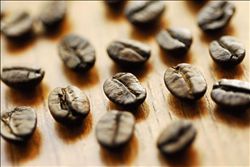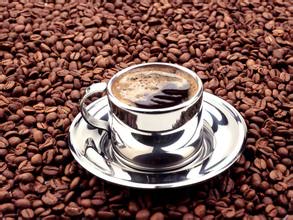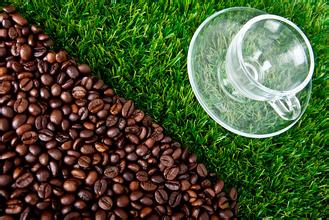Baking and storage of coffee beans China Coffee Network
Coffee bean roasting is a complicated processing technology, which is quite professional. If you want to make delicious coffee beans, you need perfect equipment and high coffee roasting technology, so unless it is for personal pleasure, it is generally not suitable for family.
With the size of the baking firepower, the length of time, coffee beans will show different depth and taste changes. Different characteristics of coffee beans, different drinking methods determine the depth of roasting of coffee beans. Generally speaking, the roasting degree is light, the coffee bean color will be light brown, the sour taste is strong, and the baking degree is deep, the hue is dark, and the bitterness is enhanced. Traditionally, the roasting of coffee beans is divided into eight different degrees:
The lightest baking (Light)-slightly yellowish coffee color, not very strong aroma and flavor
Light roasting (Cinnamon)-cinnamon color, slightly better flavor, a kind of American coffee
Ordinary roasting (Medium)-maroon, mellow, moderately sour, a kind of American coffee
Medium baking (High)-A slightly thicker baking method than shallow baking, with bitter acid and good aroma and flavor.
Medium and deep roasting (City)-the word City- comes from New York City and is a standard roasting method suitable for Colombian and New York-style coffee
Strong roasting (Full City)-no sour but bitter, suitable for iced coffee
Strong roasting (French)-French, also known as European style, due to the strong degree of baking, coffee beans fat oozing surface, dark color, strong bitterness, with a unique flavor
The strongest roasting (Italian), also known as Italian style, has a strong roasting degree, and the coffee beans are carbonized black, scorched and without aroma, so they are suitable for brewing Italian steam coffee.
Storage:
1. Raw beans:
The raw coffee beans before stir-frying are only for the convenience of transshipment, without special packaging conditions, depending on the different production areas.
For economic and practical considerations, it is generally packed in 60 kg gunny bags and further processed after arriving at the destination. Of course, there will be some different packaging, such as Jamaica Blue Mountain is packed in 70kg wooden barrels.
2. Cooked beans:
Roasted coffee beans are easy to oxidize with oxygen in the air, making the aroma volatilized, the oil quality deteriorated, and the smell of decay. How to maintain the aroma of coffee and prevent the deterioration caused by external temperature, humidity and light is the main task of coffee bean storage.
In addition, because coffee beans produce a considerable amount of carbon dioxide gas after roasting, and carbon dioxide also reduces the aroma of coffee, the packaging of cooked coffee beans should not only avoid contact with the air, but also try to remove carbon dioxide from coffee beans. At present, the commonly used coffee bean packaging methods are as follows:
Flexible non-airtight packaging: this is the most economical one. It is usually used by local small baking plants because they can guarantee rapid supply and coffee beans can be consumed in time. Coffee beans in this way can only be preserved for a short time. Usually no more than a week.
Airtight packaging: suitable for bars, shelves or families, mainly in small bags and cans, coffee is vacuum and sealed after being packed. As carbon dioxide is produced after roasting, this method can only be carried out after the coffee has been degassed for a period of time. The storage period of coffee beans should be longer than that of coffee powder. Because the storage period does not need to be separated from the air, so the cost is low. The coffee under this packing should be used up within 10 weeks.
One-way valve packaging: a variety of sealed containers can be used. The roasted coffee is put into a special airtight container with an one-way valve, which can only remove the gas without inflow, ensuring the insulation of the coffee from the outside air and the timely discharge of carbon dioxide. There is no need for separate storage stage, but due to the outgassing process, there will be a certain loss of aroma. This method can avoid the formation of rotten smell, but can not prevent the loss of aroma.
Pressurized packaging: this is the most expensive way, but it can preserve coffee for up to two years. The size depends on the type of user, family or bar. After a few minutes of baking, the coffee can be packed in a vacuum. After adding some inert gas, the appropriate pressure is maintained in the package, and the coffee beans are preserved under pressure, leaving the aroma on the fat, thus improving the aroma of the beverage.
3. Coffee powder packaging
Coffee powder is mostly used in families, so we choose small packaging, mainly small bag vacuum packaging and canning, in order to use up coffee powder as soon as possible before the quality of coffee powder is changed, among which small bag packaging is more commonly used, so the method is more economical and practical, and the processing cost is also lower.

Important Notice :
前街咖啡 FrontStreet Coffee has moved to new addredd:
FrontStreet Coffee Address: 315,Donghua East Road,GuangZhou
Tel:020 38364473
- Prev

Design principle of Coffee Straw in the production process of Coffee beans
Cappuccino iced coffee [practice] put coffee ice cubes in the cup, plus frothy sugar-sweetened milk. Slowly pour cold coffee on top. In this way, the milk and coffee are divided into two layers, and the milk foam floats on the top layer. Sprinkle some cinnamon powder. Just ok! Fancy cappuccino: cream and cinnamon Italian card on freshly brewed coffee
- Next

The origin and characteristics of coffee beans Colombian Gustav coffee
Located in the south of the country's capital, San Jos, Tarasu is one of the most valued coffee growers in the country. La Minita Tarrazu coffee is a famous local product, but its production is limited, about 72600 kilograms a year. It is grown on a piece of land called La Minita, which is owned by the McAlpine family of England.
Related
- Does Rose Summer choose Blue, Green or Red? Detailed explanation of Rose Summer Coffee plots and Classification in Panamanian Jade Manor
- What is the difference between the origin, producing area, processing plant, cooperative and manor of coffee beans?
- How fine does the espresso powder fit? how to grind the espresso?
- Sca coffee roasting degree color card coffee roasting degree 8 roasting color values what do you mean?
- The practice of lattes: how to make lattes at home
- Introduction to Indonesian Fine Coffee beans-- Java Coffee producing area of Indonesian Arabica Coffee
- How much will the flavor of light and medium roasted rose summer be expressed? What baking level is rose summer suitable for?
- Introduction to the characteristics of washing, sun-drying or wet-planing coffee commonly used in Mantenin, Indonesia
- Price characteristics of Arabica Coffee Bean Starbucks introduction to Manning Coffee Bean Taste producing area Variety Manor
- What is the authentic Yega flavor? What are the flavor characteristics of the really excellent Yejasuffi coffee beans?

